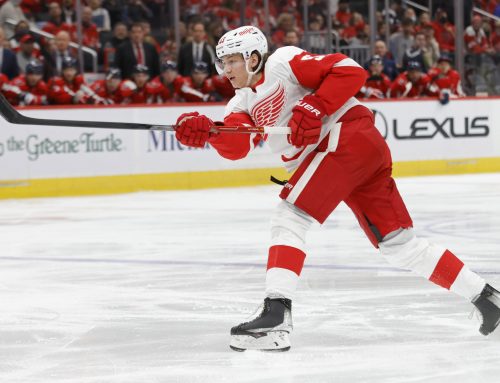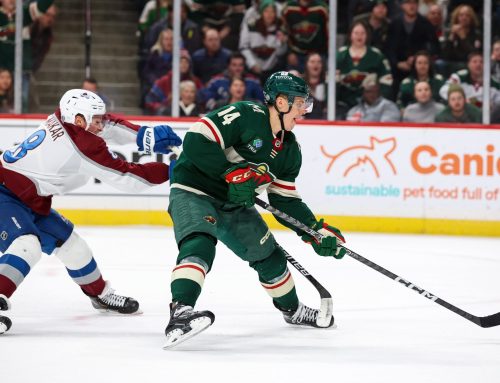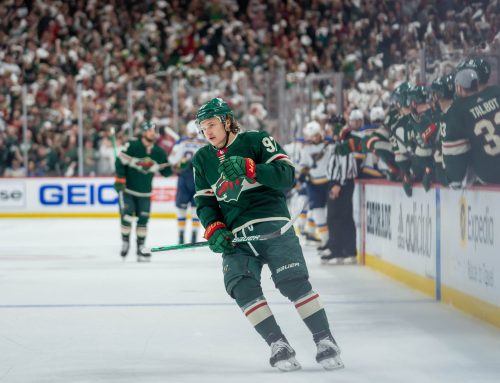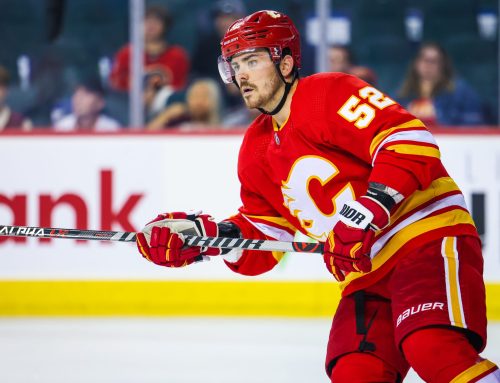Goldipucks and the Three Skaters: Bo Horvat; Anze Kopitar & Timo Meier
Rick Roos
2024-07-03
Welcome back to Goldipucks and the Three Skaters, a play on words of the Goldilocks and the Three Bears story. Instead of there being three bowls of porridge though, I cover three skaters and declare one too hot (i.e., doing unsustainably better than he should), another too cold (i.e., doing unsustainably worse), and a third “just right” (i.e., producing where he should be). In addition, I also assign each a rating of 1-10, indicating how hot (rated 7-10, where 10 is the most unsustainably hot), cold (rated 1-4, where 1 is the most unsustainably cold), or “just right” (rated 4-7, where 5.5 is the most “just right”) he is.
Perhaps by now you've started to recover from the whirlwind of the Stanley Cup finals not to mention the various trades and buyouts, and the commencement of free agency. But let this column serve as a reminder to pay attention as well to those who haven't changed teams this summer. Three such players (Bo Horvat, Anze Kopitar, Timo Meier) are being covered in this edition of Goldipucks. As usual, you should assess your fantasy radars by predicting which of the three had a 2023-24 that was too hot, versus too cold, or just right. Lock in your guesses then see if you nailed all three
Bo Horvat (81 GP, 33 G, 35 A, 248 SOG, 19:42 TOI, 18 PPPts, 2:59 PP, 66.5% PP%)
Selected ninth overall by Vancouver in 2013, Horvat was in the NHL to stay the following season. And things went well, as he saw his scoring and SOG rate, plus overall TOI, increase in each his next four seasons. The issue was Horvat had significant real-world value, such that a three season stretch saw his OZ% always below 40%. But in 2022-23 he was blazing out of the gates, giving the Canucks the chance to sell high, as J.T. Miller had just signed a massive deal and there was no way Vancouver would be able to keep both Horvat and Miller. To the Islanders Horvat went, and he fared okay for the remainder of 2022-23. This past season he produced just about as well as 2022-23. So is that his ceiling? Or could he do even better once he truly settles into Long Island? Most likely the former, as Horvat does not appear to have what it takes to realistically improve.
The Islanders certainly have help put Horvat in a position to succeed, as his 2023-24 OZ% of 55.7%, though far from sky high, was easily a career best. Also, in a change from his Vancouver days, he took the ice for far less PK time, in fact logging over 1:00 of shorthanded TOI a mere once in his last 26 games, including 12 contests with zero PK time at all. New coach Patrick Roy also wanted to see Horvat log more PP time, as his averages in Q3 and Q4 were 3:26 and 3:08 per game, after being at 2:35 and 2:48 per game in Q1 and Q2.
The PP remains a problem area for Horvat. Going back to 2018-19, Horvat's cumulative PP TOI ranks him 18th among all NHL forwards. But his PPPt total lands him all the way down at 48th. In his first full season with the Islanders, his PPPt per game rate fell. So although there is almost no realistic scenario where Horvat loses his PP1 gig, it doesn't bring with it the kind of boost in production experienced by most players. With that, it also makes him doing better less likely.
Horvat's other metrics are, simply put, not very good. Yes, he set a career best with 3.1 SOG per game and still didn't see his personal SH% decline. But this is a player who only once in his entire career has had a double-digit team SH% at 5×5. Other than when it was 10.79% that season, it's never been above 8.80%. Plus, despite getting top line deployment all season, his rate went from 8.8% in 2022-23 to 8.4% in 2023-24. It created a bit of a contagion, as he also brought down that number for linemate Mathew Barzal.
What's interesting though is Horvat's cumulative PPG total in that stretch of seasons put him in 14th among forwards, meaning he had far more PPGs than would be expected based on his cumulative PPPts. But the only player with more PPGs and fewer PPPts during this period was Chris Kreider, who as we all know has never been a point per game player and only twice scored at even a 60+ point pace. That is not an encouraging comparable.
Then there are Horvat's IPPs. This marked the seventh season his PP IPP was below 57%; and if that wasn't bad enough, only once in his past five seasons was it above 47.8%. That is abysmal for a player who's been glued to PP1. It would be one thing if it had bounced up and down, or he hadn't been a PP1 staple. For someone to nab as few points on the PP as Horvat, that is exception, in a bad way. After all, as is the case for nearly all teams in today's NHL, Vancouver and the Islanders ran a PP1 with four forwards. Although not every PPG will necessarily have two assists attached to it, most will. So for the majority of PPGs, each forward should have an 20% chance of getting one of three PPPts. Yes, I realize that Quinn Hughes and the 2023-24 version of Noah Dobson factored into PP scoring more so than a normal PP1 defenseman; however, on average if four forwards are on the ice on each PP, those four should nab 2.4 of every 3 PPPts (i.e., 0.8×3). Divide that by four, and you get 0.6; so an "average" PP forward should have an IPP of roughly 60%. This shows just how far below average Horvat is, and, worse yet, there are no signs of improvement.
It's not like his overall IPP is much better. I realize that his PP IPP does bring it down; but still it too should be better than what it's been, which is 57.4% to 62.5% in each of the last seven seasons, with it being under 60% in three of the last four, including 2023-24. There is no way to sugarcoat it – Horvat is not a points magnet. That, combined with his low team SH%, is a double whammy, as his presence doesn't lead to ample scoring, plus what scoring there is he doesn't factor into very often. For those clinging to hope in terms of his secondary assist rate, it was 45.7% in 2023-24, which, although not high by any means, also was not low.
I bet all of you reading this are thinking I'm going to say that Horvat's 2023-24 was too hot. Nope, I think it was JUST RIGHT, and he gets a rating of 5.5. The key is it although there is little to no realistic hope for things to get better, they probably can't really get worse, as due to his contract and New York's lack of viable alternatives, Horvat will still get ample PP time and overall TOI. Expect Horvat to keep scoring at a roughly 70-point pace, with a chance at more if the team around him improves and a rising tide lifts his boat.
Anze Kopitar (70 GP, 11 G, 46 A, 202 SOG, 24:27 TOI, 12 PPPts, 2:44 PP, 62.0% PP%)
Amazingly, Kopitar was drafted nearly two decades ago. He was in the NHL to stay at age 20, and embarked on what has been a consistently great but never quite superb career. This past season he was still in his familiar spot on LA's top line, with a scoring rate squarely in line with the 68-73 point range it'd been the prior four seasons. Can Kopitar keep father time at bay, or might he be headed for a downswing? Signs point to the latter.
Although Kopitar's scoring rate held steady and he potted 26 goals, he had just 133 SOG, translating to 1.6 per game. No one who scored 25+ goals in 2023-24 did so while taking fewer SOG than Kopitar. Plus, of the 83 forwards who scored 20-25 goals, a mere six had fewer SOG: Anthony Duclair, Anthony Mantha, Andrei Kuzmenko, Anthony Cirelli, and Michael Carcone. Not very good comparables to say the least.
But it gets worse, as Kopitar scored his 26 goals without hitting a single post or crossbar. And of the two players last season who had 30+ goals while hitting three or fewer posts (Dylan Cozens, Andrei Kuzmenko), both saw their scoring decline significantly in 2023-24. So Kopitar likely was due to score even fewer goals than would already have been expected, even from a selective shooter.
On top of that, Kopitar, who admittedly has always been a pretty accurate shooter, had a career best in SH% at 19.5%. Had he shot his prior career rate of 12.5%, then he'd have only potted 16 goals, not 26. There is a trifecta of reasons why Kopitar likely scored 5-10+ more goals this season than he should have. Yes, admittedly some of those goals could have been repackaged instead as assists; however, almost assuredly there would not have been enough to make up for the excess of goals he did score.
Another concern about Kopitar is he only scored as much as he did because his 61.73% percentage of games with a point was higher than it should have been for someone who only had 70 points. In fact, of the 24 forwards who played 80+ games and posted 60-70 points, only Joe Pavelski had a higher percentage than Kopitar's, and we know that Pavelski's scoring had been trending down. The reality is Kopitar's ability to score in bursts is diminishing with age. Next to go will be his consistency, perhaps sooner than later if Pavelski is any indication.
As noted above, Kopitar's career can be summed up as very good but rarely great. As a testament to that, in the history of the NHL his 12 seasons with a scoring rate of 0.85 to 1.0 is three higher than the center with the next highest total, John Tavares with nine.
How did other centers fare who met the scoring rate criteria several times and played to age 37, which is how old Kopitar will be in 2024-25? Patrice Bergeron met the criteria six times and saw his scoring rate drop from 65 points in 73 games at age 36, to 58 in 78 games at age 37. Henrik Sedin, who met the criteria seven times, was already down to 50 points in 82 games at age 36, but managed to duplicate those exact numbers at age 37. Joe Thornton met the criteria only six times, but went from exactly point per game output at age 36 to 50 points in 79 games at age 37. Although none of these players is a perfect comparison, what we see from them – plus Pavelski – is not encouraging with regard to what to expect from Kopitar at age 37 this coming season.
Also concerning is Kopitar's lower IPPs, as on the PP in 2023-24 it was 59.0%, after being 52.6% in 2022-23 but above 70% the nine prior seasons. As for overall IPP, it was 64.2%, which is not terrible by any means, yet represented a career low for Kopitar, and this too was an area where he'd thrived, finishing above 70% in seven of the prior nine seasons, but also under 70% in 2022-23. These are not good numbers to see, especially since they're the second season in a row of him being well below his norms.
Kopitar's secondary assist rate was not elevated; however, it also was not well below his norm, so he likely won't be making gains there to remotely come close to offsetting the goals and points he's on course to lose. Also, his OZ%, while only 48.8%, marked his highest percentage since 2016-17; so if anything, he should've done even better. Although his spot on PP1 was not challenged, his PP TOI dropped with each quarter, going from 3:51 per game in Q1 to 2:43 per game in Q4. That's a whole minute lost during the course of one season, which is a disconcerting trend.
If this were a boxing match, the crowd would be yelling "stop the fight!" as the data for Kopitar is ugly from pretty much all vantage points. No question his 2023-24 was TOO HOT. I think there is a good chance the bottom falls out from under him, as it did with several other players at a similar age. In fact, banking on more than 55 points might be a stretch. For that reason, I give Kopitar a 9.5 rating and advise that if you own him in keeper try to trade him before the 2023-24 campaign begins, even if you take less than his name value should net you.
Timo Meier (69 GP, 28 G, 24 A, 207 SOG, 17:36 TOI, 17 PPPts, 2:22 PP, 46.7% PP%)
A former ninth overall pick, Meier was an NHL mainstay by age 21 and turned heads when in his second full season he scored at a 69 point pace while adding some nice peripherals on top of his offensive output. Alas, his scoring rate dropped each of the next two seasons, but in 2021-22 he ended the campaign just below the point per game mark, firing over four SOG per game and also averaging over two hits per contest. Yet those who envisioned him as the NHL's next multicat superstar were disappointed when he yet again scored at a lower rate the next two seasons, and they grew even more concerned when rather than doing better on New Jersey as many had predicated, he was faring worse. How will 2024-25 unfold for Meier? Likely a good bit better.
On the surface, 2023-24 looked like a disaster for Meier, with a terrible +/-, barely making it to three SOG per game, and shedding PPPts and Hits. I have written that I felt Meier could be a misfit in New Jersey, and in 2022-23 that seemed to be the case, as he was put on a line with Jack Hughes, with both the high volume shooters faring worse. Yet New Jersey
tried Meier with Hughes again in Q1 of 2023-24; and although Hughes excelled, it came at the cost of Meier's success. Not surprisingly, Meier was separated from Hughes by Q2; but rather than getting a chance to skate with Nico Hischier, he played in Q2 and Q3 with the likes of Dawson Mercer, Michael McLeod, and Curtis Lazar. Not surprisingly, this failed to lead to improvement for Meier.
Finally in Q4 New Jersey trialed Meier with Nico Hischier, a defensive-minded forward who also has offensive acumen, and the results were magical. Meier erupted for 24 points in 21 games. His ice time also rose back to 19:31 per game, with a full minute jump in PP time, which led to him tallying ten of his 17 PPts in just those 24 games. Also, although his SOG rate remained below the four per contest we'd come to expect from him, he was back to just under 3.5 per game. Yes, 15 of those points were goals, and the end result was a bit of an inflated SH%; but Meier also had a higher than normal rate of SOG from 0-15 feet versus past seasons, such that a somewhat higher SH% would be expected, and, more importantly, sustainable if this is his new normal.
One concern with Meier had always been that his very good to great IPPs were a function of him mostly playing on lines with those of a lower skill set. Indeed, both this past season and his last were the only in his career where both his IPP on the PP and overall IPP were below 70%; however, for 2023-24 they were 69.3% overall and 68.0% on the PP. Those ought to be more than high enough for him to excel in the Garden State. Yes, they reflect Q2 and Q3 when he played with less talented linemates; however, they also factor in Q1 when he played with Hughes and Q4 when he played with Hischier plus Jesper Bratt. So things are looking up in this area.
Also nice to see is despite Meier's lower scoring for the season, his 9.2% 5×5 team SH% was tied for his highest rate since 2018-19. And his OZ% was only 51.5%, down from 59.5% in 2022-23. If he does stay stapled to Hischier, that number might not climb; however, he will benefit from having talent on the same line, for what would likely be a net positive.
What about player comparables? Since 2000-01, just one other winger had two seasons by age 26 in which they averaged 4.1+ SOG, between 0.8 and 1.0 Points Per Game, plus tallied at least 12 PPGs, and that's Alex DeBrincat. Given what he's done of late, that is not very encouraging. Among those who did so once, there is Brock Boeser and David Pastrnak, so perhaps this is not concerning after all.
Lastly, Meier's previous pattern was an up season, followed by two down ones. If that holds true to form, 2024-25 would be an up season. I realize the data already suggested that to be the case, but file this under possibly interesting coincidences.
On the surface, the Meier in New Jersey experiment seems to not have been a success. But what lurks beneath the overall numbers is a very strong Q4, plus a rebound in shot rate accompanied by better shot selection. All these point to Meier's 2023-24 as having been TOO COLD, and he gets a rating of 1.75, as I'd expect him to climb to at least 75 points, with it being more likely he rises to 80 than falls below 70.
***********************
Questions for Mailbag
My next monthly mailbag has room for more questions. To get yours to me, you can either send (1) a private message to “rizzeedizzee” via the DobberHockey Forums, or (2) an email to [email protected] with “Roos Mailbag” as the subject line.





 BUF
BUF N.J
N.J ANA
ANA VAN
VAN DET
DET MTL
MTL DAL
DAL UTA
UTA WSH
WSH
